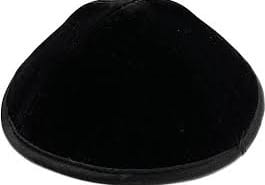Why Do Charedim Wear Black, Two-Layered Yarmulkas?

The yarmulka (kippah) is not just a piece of fabric; it is a declaration of identity, of yiras Shamayim, of submission to Hashem. For Charedi Jews, the black two-layered yarmulka is more than a style—it is an expression of halachah, tzeni’us, separation from secular culture, and continuity with mesorah.
Let us explore each part—color, branding, layering, and size—with Torah sources, halachic reasoning, and hashkafic clarity.
1. Why Wear a Yarmulka at All?
The Gemara says:
"לעולם תהא אימת שמים עליך." “The fear of Heaven should always be upon you.” — Berachos 28b
And further:
"מכסה אני את ראשי שלא תהא עלי אימת שמים." “I cover my head so that the fear of Heaven should be upon me.” — Shabbos 156b, Rashi
The yarmulka is not a fashion choice. It’s a halachic and spiritual tool to cultivate yiras Shamayim—a constant reminder that Hashem is above.
2. Why Black?
Charedim wear black yarmulkas because:
- Black is the color of dignity and humility, not flamboyance.
- It is not attention-seeking or trendy.
- It reflects seriousness and consistency in avodas Hashem.
Chacham Ovadia Yosef zt”l wrote:
"מראשית הדורות ועד היום נהגו חכמי ישראל לחבוש כיסוי ראש שחור כסימן לצניעות והכנעה." “From early generations until today, the sages of Israel wore black head coverings as a sign of modesty and humility.” — Yabia Omer, O.C. 6:15
3. Why Not Colorful, Branded, or Sports-Themed Kippahs?
Charedim avoid colored, patterned, or branded kippahs for several reasons:
A. Lack of Tzeni’us
A bright red or cartoon-covered kippah is a statement piece. But Charedi dress—especially in matters of kedushah—is about blending in, not standing out.
B. Bittul Hayira
A yarmulka with a basketball team logo or a cartoon character turns a symbol of yiras Shamayim into a billboard for secularism.
Rav Shmuel Wosner zt”l ruled: “It is forbidden to wear a yarmulka with writing or images, especially of pritzus or secular culture.” — Shevet HaLevi 9:1
C. Influence of Goyish Culture
Rav Yaakov Kamenetsky zt”l was known to oppose anything that blurred the boundary between Jewish values and Americanism. A yarmulka is not a baseball cap. It should not advertise Western sports or brands.
As he said: "The yarmulka is not a canvas. It's a crown. Treat it like one."
4. Why Two Layers?
The two-layered velvet yarmulka—one stitched inside the other—is a minhag that took hold in the Charedi world for three main reasons:
A. Extra Coverage and Structure
It helps the yarmulka stay on more securely and sit fully on the head, not halfway off. This fulfills the halachic ideal of a proper head covering—not just a token patch.
B. Avoiding Resemblance to Secular Caps
Single-layer velvet caps can sometimes resemble fashion beanies or small berets. The double-layered form preserves its Jewish character, making it clear: this is for yiras Shamayim, not a fashion trend.
C. Chizuk B’Yiras Shamayim
Rav Chaim Kanievsky zt”l once remarked (as quoted in Orchos Yosher):
"מי שמחמיר בכיסוי ראשו ומקפיד על ירא"ש, זוכה להארת פנים מהשמים." “One who is stringent with his head covering and careful in fear of Heaven merits illumination from Above.”
The double layer is seen as a hidur—a beautification—of this constant mitzvah-like behavior.
5. What About the Size of the Yarmulka?
Shulchan Aruch rules that a head covering must be significant enough to be seen clearly as such (Orach Chaim 2:6, 91:4).
The Mishnah Berurah (O.C. 2:11) writes:
"כיסוי קצת ראש לא מהני." “Covering only part of the head does not suffice.”
Very small yarmulkas—nicknamed “postage stamps” or “kippat Obama”—do not fulfill the spirit of the halacha, even if some claim they meet the letter of it.
Rav Elyashiv zt”l ruled explicitly:
"כיפה קטנה מאוד – אין זה כבוד לתפילה ולא מסמל יראת שמים." “A very small kippah is neither respectful for prayer nor a symbol of yiras Shamayim.” — Vaya’an Yosef, Hilchos Tefillah
6. But Isn’t This Just a Minhag?
Minhag Yisrael Torah hi. The black, velvet, two-layered yarmulka is a living minhag—one that has become the uniform of Bnei Torah, yeshiva bochurim, and ehrliche yidden who proudly display their submission to Hashem.
As the Steipler Gaon zt”l wrote in Karyana D’Iggarta (vol. 1, letter 59):
"האדם ניכר בכיפה שעל ראשו – ובה ניכר האם הוא ירא שמים באמת או מחפש מציאות." “A man is known by the yarmulka on his head—it reveals whether he truly fears Heaven or is looking for convenience.”
Conclusion: A Crown, Not a Cap
The Charedi yarmulka is not an accessory. It is a crown—a daily sign of reverence, an anchor to tradition, and a rejection of secular influence.
It doesn’t have to be black. But black is the most dignified, timeless, and unifying choice. It doesn’t have to be velvet. But velvet reminds us of the royalty we carry.
And it certainly doesn’t need to advertise a team, a TV show, or a trend. It only needs to remind you:
“שיויתי ה' לנגדי תמיד.” “I place Hashem before me always.” (Tehillim 16:8)
Footnotes:
- Berachos 28b, Shabbos 156b, with Rashi
- Shulchan Aruch, O.C. 2:6, 91:4
- Mishnah Berurah O.C. 2:11
- Yabia Omer, Orach Chaim 6:15
- Shevet HaLevi, 9:1
- Orchos Yosher, Rav Chaim Kanievsky on Yiras Shamayim
- Vaya’an Yosef, Hilchos Tefillah
- Karyana D’Iggarta, vol. 1, letter 59 (Steipler Gaon)
